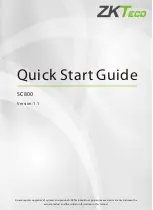
Barrier Systems by Lindsay
+1 (888) 800-3691 (U.S. toll free or +1 (402) 829-6800 - ECN 60881
11
ARMORGUARD® BARRIER
ArmorGuard Barrier Operation on Sloped
Surfaces
Lindsay Transportation Solutions Sales and Services, Inc
(888) 800-3691 [U.S. toll free] or +1 (707) 374-6800
Lindsay Transportation Solutions Sales and Services, Inc
(888) 800-3691 [U.S. toll free] or +1 (707) 374-6800
12
ArmorGuard Barrier Operation on Sloped
Surfaces
The ArmorGuard Barrier is designed to be placed on
surfaces (that are in compliance with that stated in the
Product Specifications) with slopes up to 8% (<5°).
The AGB shall be capable of performing in compli-
ance with the requirements for a longitudinal barrier in
the National Cooperative Highway Research Program
Report 350 (NCHRP 350), Test
Level 3, when installed in this condition. However, if
the AGB is to be installed on a sloped surface, provi-
sions need to be made to always ensure that there is
positive control of the system in the opening and clos-
ing operations. Lack of positive control could lead
to potential injury of operating personnel or adjacent
motorists if the system were to swing open or closed
in an uncontrolled manner.
To ensure that the system is positively controlled, a
rope, or ”tether line,” with a tensile capacity of at least
2000 pounds (900 kg) should be connected between
the removable AGB element and the system. Antici-
pated lateral loading from an 8% slope should be less
than 200 pounds (90 kg). Once the “tether line” is
firmly connected, remove the hinge pin and then raise
the system onto the wheels. The system should be
raised slowly and only a small amount (to just come
onto the wheels) to keep positive. If the barrier starts
to move, tilt it slightly so that the rubber pads act as
a friction brake and then slowly play line out to guide
the section in the desired location.
Typically, the tether line should be attached between
the “uphill” elements, since the moveable element will
have a tendency to roll downhill when the system is
raised onto the wheels.
The same tether line system can be used to pull the
system back into position when it is being closed. Do
not disconnect the tether line until the hinge pins are
in the locked position, the barrier is lowered onto the
road surface, and the system is secured.
If it is necessary to disconnect the tether line without
the hinge pins being locked in place, lower the barrier
to put the full weight of the section onto the rubber
pads resting on the road surface and with the wheels
not touching the road surface.
ArmorGuard Barrier Towing Specifications
The ArmorGuard Barrier can be rolled manually around a
job site over any solid ground that can support its weight.
Deep troughs or potholes are not acceptable since the
wheels will drop into the depression and the barrier will
high center.
The ArmorGuard Barrier can be towed short distances at
low speeds. Care must be taken to ensure safety, reliabili-
ty, and to limit damage and wear to the system. A smooth,
flat road surface is necessary for longitudinal transfers
longer than the length of the system being moved, (usually
400-1000 feet). If any of the following specifications can
-
not be met, the system must be alternatively transported.
Surface Conditions for Towing:
•
Smooth surface capable of supporting the weight
of the system
•
No potholes, rumble strips, or raised pavement
markers
•
Less than 2 degree cross slope
It is acceptable to tow a system across a rumble strip
or raised pavement markers as long as the speed is
less than 1 MPH.
Towing Control:
•
A pivoting or flexible attachment should be used to
connect the tow vehicle to the Link series (exam-
ple: chain, strap, or link bars). This limits exces-
sive wear to the front wheel assemblies.
•
The first (3) tiller positions behind the tow vehicle
must be manually steered as the tow vehicle
turns to minimize scrubbing.
•
Proper tethering or restraints should be used when
navigating cross slopes or descents to ensure
control at all times.
•
Adequate personnel must be utilized to control the
system while under tow. The system requires
monitoring and steering corrections at various til-
ler locations in the series.
ARMORGUARD
®
BARRIER
ArmorGuard Barrier Towing Specifications































